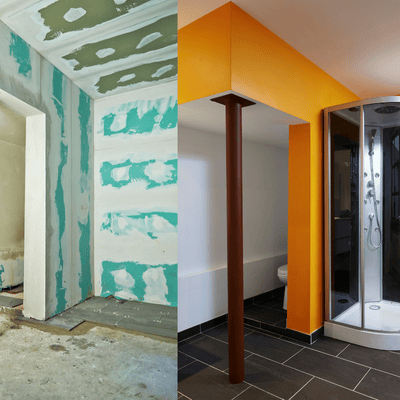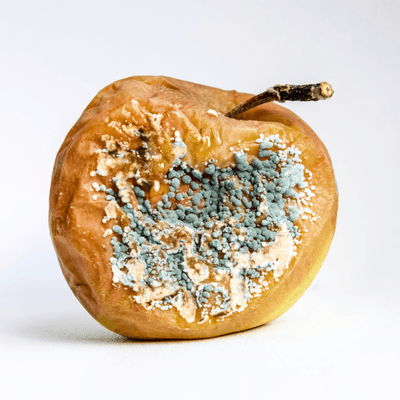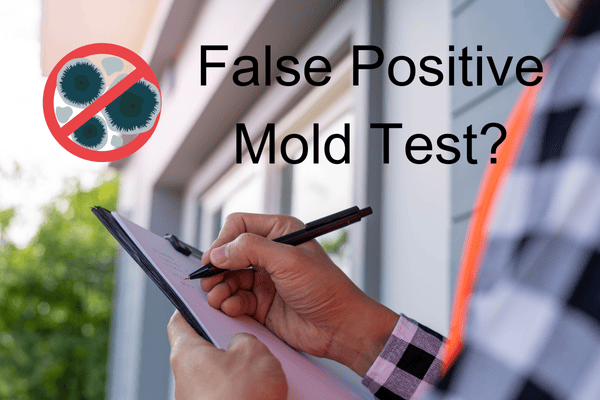Mold testing might seem like a straightforward process, but results can often be more complicated than they appear. While a mold test can be a helpful diagnostic tool if you’re noticing moisture or odors in your home, it’s not always foolproof.
In fact, some tests can result in false positives, creating the impression of a serious mold problem where there isn’t one—or where the issue is far less drastic.
That’s why it’s crucial to work with a mold testing company that truly understands the various factors that can affect test results, digging deeper to uncover what’s really going on.
An experienced inspector doesn’t rely solely on spore counts; they investigate, spot potential triggers for false positives, and get to the real root of any problem.
With a trustworthy assessment, you’ll avoid unnecessary, costly repairs and have the peace of mind to make an informed decision.
13 Possible Reasons for a False Positive Mold Test
Here are 13 surprising factors that can trigger a false positive on a mold test, helping you better understand your results and potentially save you from gutting your home.
1. High Humidity
High humidity, especially in summer or rainy seasons, can elevate mold spore counts even in a home without significant mold issues. Imagine you’re testing in a humid summer month; the naturally higher humidity levels could make airborne spores seem more concentrated than they typically would.
A knowledgeable inspector will recognize this factor and may suggest retesting on a less humid day or examining humidity levels before making recommendations.
2. Waterproof Building Materials

Certain materials in your home, like waterproof drywall, tile, or treated wood, are designed to hold surface moisture, especially in bathrooms. If you test for mold in these areas and get high moisture readings, it’s possible that the waterproof materials are affecting the results rather than actual mold growth.
An experienced inspector will know that these materials can give false impressions of water damage and will look beyond surface readings to assess the situation accurately.
3. Recent Cleaning or Disturbance
If you’ve just vacuumed, dusted, or swept an area before a mold test, disturbed dust and spores can lead to temporarily elevated levels. Say you cleaned your living room right before the inspection; those newly airborne particles might skew the results. All indoor environments have mold spores in them to some degree and are often undetectable.
A careful inspector will consider recent cleaning activity and may recommend waiting a few days after cleaning to allow for a more accurate reading.
4. Poor Ventilation
In spaces with poor ventilation, like basements or attics, spores can become trapped, resulting in higher counts in those areas. If you’re testing a musty basement, it could be that stagnant air is amplifying the appearance of mold spores, even if mold growth isn’t extensive.
Inspectors who are familiar with ventilation issues will understand that poor airflow can make spore counts seem higher and factor that into their analysis.
5. Dust and Debris
Dust can contain organic material, which, under certain testing methods, may mimic mold spores. For example, if you live on a busy street, dust that gets into your home may lead to a higher spore count on a mold test.
An experienced inspector will know to differentiate between dust and mold spores, potentially using more precise tests to avoid false positives.
6. HVAC Systems
Turning on your HVAC system after it’s been idle for months can release dust and spores that have accumulated in the ducts. If you’ve just switched on your air conditioning prior to the mold test, high spore counts may detected. It’s likely the HVAC system has stirred up dormant spores rather than indicating a major mold problem.
A good mold inspector will ask about HVAC usage and may inspect the system itself before concluding that remediation is needed.
7. Indoor Plants and Organic Materials

Indoor plants or even soil can release harmless spores into the air, especially when watered. If a mold test is conducted near your houseplants, the spores from the soil might increase counts in the test results, even if there’s no structural mold problem.
An experienced inspector will take note of nearby plants and organic materials and adjust their findings to avoid an unnecessary response.
8. Nearby Outdoor Mold Sources
If your home is close to a wooded area, lake, or other natural environment, outdoor spores can easily make their way inside. For example, if you leave windows open to enjoy the fresh air, spores from outside may temporarily raise indoor spore counts.
A good inspector will consider your home’s location and ventilation habits to determine whether outdoor mold sources might be skewing the results.
9. Sampling Location
Taking samples too close to naturally moist areas, like a damp basement or bathroom, can make mold levels seem more serious than they are. If a sample is taken from a particularly humid spot, the results may not reflect the overall mold levels in your home.
An experienced inspector will know to take samples in representative areas, rather than just high-humidity spots, for a more balanced assessment.
10. Poor Sampling Technique
Sampling technique can significantly affect test results. If an inspector takes too few samples or collects samples from only one area, it may give an incomplete picture. For example, testing only in one corner of a room may not represent the spore levels throughout your home.
A reputable inspector will use standardized sampling methods and ensure the results reflect the conditions of the entire space.
11. Recent Water Exposure
If you’ve recently fixed a leak or spilled water, dampness might still be present in that area, leading to high moisture readings. Let’s say there was a small leak under your sink that was just fixed; moisture from that recent repair could lead to elevated spore counts, even if mold hasn’t had time to develop.
A knowledgeable inspector will look for signs of actual mold growth, not just temporary moisture, before concluding that remediation is necessary.
12. Forgotten Organic Debris

Sometimes, it’s the simple things—like a bag of old potatoes or a damp towel—that can cause localized mold. During testing, spores from these isolated sources may be detected, giving the impression of a larger issue.
An inspector who digs a little deeper will recognize if the spore count is tied to a specific item rather than a widespread mold problem, helping you avoid unnecessary remediation.
13. Low-Quality Lab Analysis or Equipment
Not all labs or testing equipment deliver accurate results. If an unreliable lab is used, you may receive skewed results that don’t actually reflect your home’s conditions. For instance, poorly calibrated equipment could show elevated levels even in a mold-free area.
A qualified mold inspector will work with trusted labs and calibrated equipment to ensure the readings you receive are accurate and reliable.
Avoid False Positive Mold Tests With Reliable Mold Inspection
Mold testing can be incredibly helpful, but false positives sometimes lead to unnecessary stress and expenses. Before committing to costly repairs, consider getting a second opinion from an inspector who knows how to interpret results accurately. At Howard Environmental, we specialize in second opinions and frequently save our clients thousands by identifying what’s really going on. Reach out today for an honest, thorough assessment and the peace of mind that you’re only investing in solutions you truly need.

